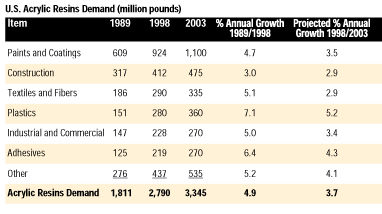U.S. Demand For Acrylic Resins To Reach 3.3 Billion lb In 2003

The largest-volume application for acrylics will continue to be in the manufacture of paints and coatings. Acrylic monomers (both acrylate and methacrylate types) are widely used as the base resin in coatings due to their compatibility in reformulated products. The bulk of demand is concentrated in architectural coatings, where product reformulation has nearly reached saturation levels. Growth will therefore be greater in industrial and specialty coatings, an area in which reformulation has lagged due to higher performance requirements.
The most rapidly growing applications for acrylic monomers include adhesives, plastics and several small-volume specialty uses. In adhesives, demand will benefit from the growing use of acrylate monomers in the production of water-based pressure sensitive adhesives, which are expanding their presence in a range of packaging applications. Acrylates are also widely used as co-monomers and property modifiers in specialty plastics, including ethylene ethyl acrylate and ethylene methyl acrylate. Other growth opportunities exist in such areas as medical products, where acrylics’ toughness, clarity, biocompatability and ability to withstand chemical- or gamma-radiation sterilization, make them suitable for use in contact lenses, drug-delivery systems and other medical instruments.
Exports of acrylic monomers from the United States will slow, as foreign additions to capacity come online, particularly in the Asia/Pacific region. In spite of the recent economic problems in that region, capacity is expected to increase significantly, eroding export markets for U.S. producers. Imports to the United States are expected to outpace gains in production, particularly for methyl methacrylate manufactured in Europe.
Acrylic Resins (published December 1999, 272 pages) is available from The Freedonia Group, Inc., 767 Beta Dr., Cleveland, OH 44143-2326; phone 440-684-9600; fax 440-646-0484; e-mail pr@freedoniagroup.com Full text is also available online through commercial database companies and the www.freedoniagroup.com Web site.
Links
Looking for a reprint of this article?
From high-res PDFs to custom plaques, order your copy today!


